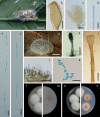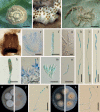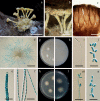Comprehensive treatise of Hevansia and three new genera Jenniferia, Parahevansia and Polystromomyces on spiders in Cordycipitaceae from Thailand
- PMID: 36760890
- PMCID: PMC9849099
- DOI: 10.3897/mycokeys.91.83091
Comprehensive treatise of Hevansia and three new genera Jenniferia, Parahevansia and Polystromomyces on spiders in Cordycipitaceae from Thailand
Abstract
Collections of pathogenic fungi found on spiders from Thailand were selected for a detailed taxonomic study. Morphological comparison and phylogenetic analyses of the combined ITS, LSU, tef1, rpb1 and rpb2 sequence data indicated that these specimens formed new independent lineages within the Cordycipitaceae, containing two new genera occurring on spiders, i.e. Jenniferia gen. nov. and Polystromomyces gen. nov. Two new species in Jenniferia, J.griseocinerea sp. nov. and J.thomisidarum sp. nov., are described. Two strains, NHJ 03510 and BCC 2191, initially named as Akanthomycescinereus (Hevansiacinerea), were shown to be part of Jenniferia. By including sequences of putative Hevansia species from GenBank, we also revealed Parahevansia as a new genus with the ex-type strain NHJ 666.01 of Pa.koratensis, accommodating specimens previously named as Akanthomyceskoratensis (Hevansiakoratensis). One species of Polystromomyces, Po.araneae sp. nov., is described. We established an asexual-sexual morph connection for Hevansianovoguineensis (Cordycipitaceae) with ex-type CBS 610.80 and proposed a new species, H.minuta sp. nov. Based on characteristics of the sexual morph, Hevansia and Polystromomyces share phenotypic traits by producing stipitate ascoma with fertile terminal heads; however, they differ in the shape and colour of the stipes. Meanwhile, Jenniferia produces non-stipitate ascoma with aggregated superficial perithecia forming a cushion. A new morphology of ascospores in Jenniferia is described, illustrated and compared with other species in Cordycipitaceae.
Keywords: Cordycipitaceae; Hevansia; Jenniferia; Parahevansia; Polystromomyces; spider pathogenic fungi.
Suchada Mongkolsamrit, Wasana Noisripoom, Kanoksri Tasanathai, Noppol Kobmoo, Donnaya Thanakitpipattana, Artit Khonsanit, Booppa Petcharad, Baramee Sakolrak, Winanda Himaman.
Figures








Similar articles
-
New mycoparasitic species in the genera Niveomyces and Pseudoniveomycesgen. nov. (Hypocreales: Cordycipitaceae), with sporothrix-like asexual morphs, from Thailand.Fungal Syst Evol. 2023 Nov;12:91-110. doi: 10.3114/fuse.2023.12.07. Epub 2023 Aug 28. Fungal Syst Evol. 2023. PMID: 38533477 Free PMC article.
-
Phylogenetic diversity and morphological characterization of cordycipitaceous species in Taiwan.Stud Mycol. 2024 Dec;109:1-56. doi: 10.3114/sim.2024.109.01. Epub 2024 Jun 19. Stud Mycol. 2024. PMID: 39717658 Free PMC article.
-
Is Hyperdermium Congeneric with Ascopolyporus? Phylogenetic Relationships of Ascopolyporus spp. (Cordycipitaceae, Hypocreales) and a New Genus Neohyperdermium on Scale Insects in Thailand.J Fungi (Basel). 2022 May 17;8(5):516. doi: 10.3390/jof8050516. J Fungi (Basel). 2022. PMID: 35628771 Free PMC article.
-
Johnwellsia, a new intertidal genus of Parastenheliidae (Copepoda, Harpacticoida) from the Taiwan Strait, China, including a review of the family and key to genera.Zootaxa. 2021 Oct 12;5051(1):236-318. doi: 10.11646/zootaxa.5051.1.13. Zootaxa. 2021. PMID: 34810900 Review.
-
A review of the leafhopper tribe Hyalojassini (Hemiptera: Cicadellidae: Iassinae) with description of new taxa.Zootaxa. 2015 Jan 16;3911(1):1-42. doi: 10.11646/zootaxa.3911.1.1. Zootaxa. 2015. PMID: 25661594 Review.
Cited by
-
Unravelling the fungal darkness in a tropical cave: richness and the description of one new genus and six new species.Fungal Syst Evol. 2022 Dec;10:139-167. doi: 10.3114/fuse.2022.10.06. Epub 2022 Nov 1. Fungal Syst Evol. 2022. PMID: 36741552 Free PMC article.
-
New mycoparasitic species in the genera Niveomyces and Pseudoniveomycesgen. nov. (Hypocreales: Cordycipitaceae), with sporothrix-like asexual morphs, from Thailand.Fungal Syst Evol. 2023 Nov;12:91-110. doi: 10.3114/fuse.2023.12.07. Epub 2023 Aug 28. Fungal Syst Evol. 2023. PMID: 38533477 Free PMC article.
-
Two new species and one new combination of Ophiocordyceps (Hypocreales, Ophiocordycipitaceae) in Guizhou.MycoKeys. 2024 Feb 29;102:245-266. doi: 10.3897/mycokeys.102.113351. eCollection 2024. MycoKeys. 2024. PMID: 38463694 Free PMC article.
-
Fungal Planet description sheets: 1550-1613.Persoonia. 2023 Jun;51:280-417. doi: 10.3767/persoonia.2023.51.08. Epub 2023 Dec 30. Persoonia. 2023. PMID: 38665977 Free PMC article.
-
Phylogenetic diversity and morphological characterization of cordycipitaceous species in Taiwan.Stud Mycol. 2024 Dec;109:1-56. doi: 10.3114/sim.2024.109.01. Epub 2024 Jun 19. Stud Mycol. 2024. PMID: 39717658 Free PMC article.
References
-
- Bischoff JF, White Jr JF. (2004) Torrubiellapiperis sp. nov. (Clavicipitaceae, Hypocreales), a new teleomorph of the Lecanicillium complex. Studies in Mycology 50: 89–94.
LinkOut - more resources
Full Text Sources
